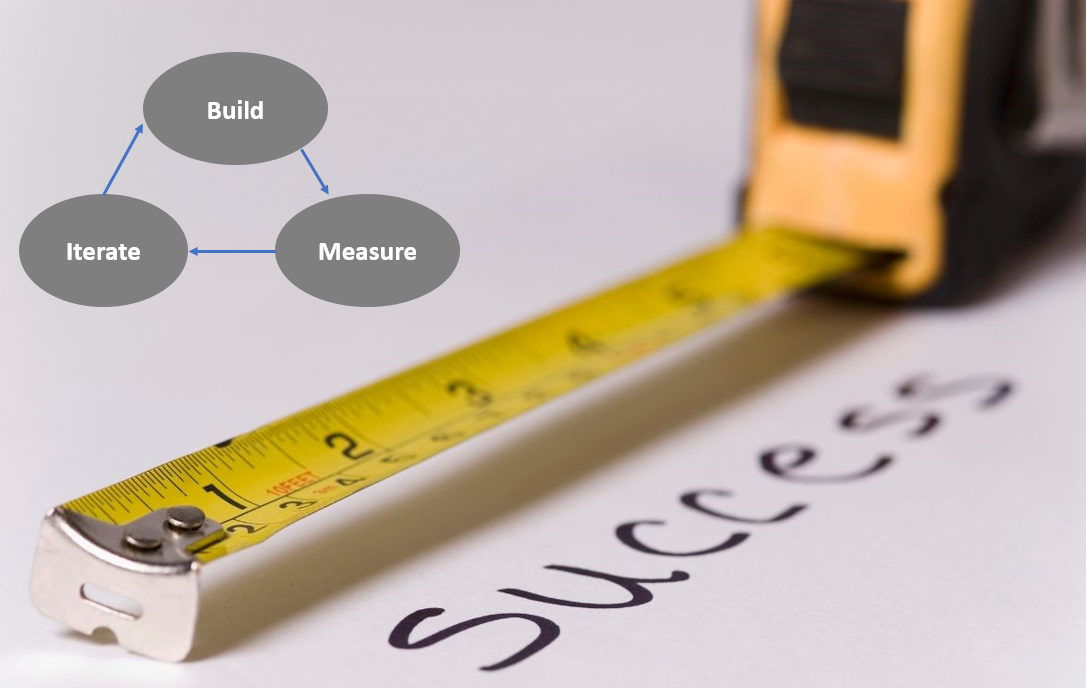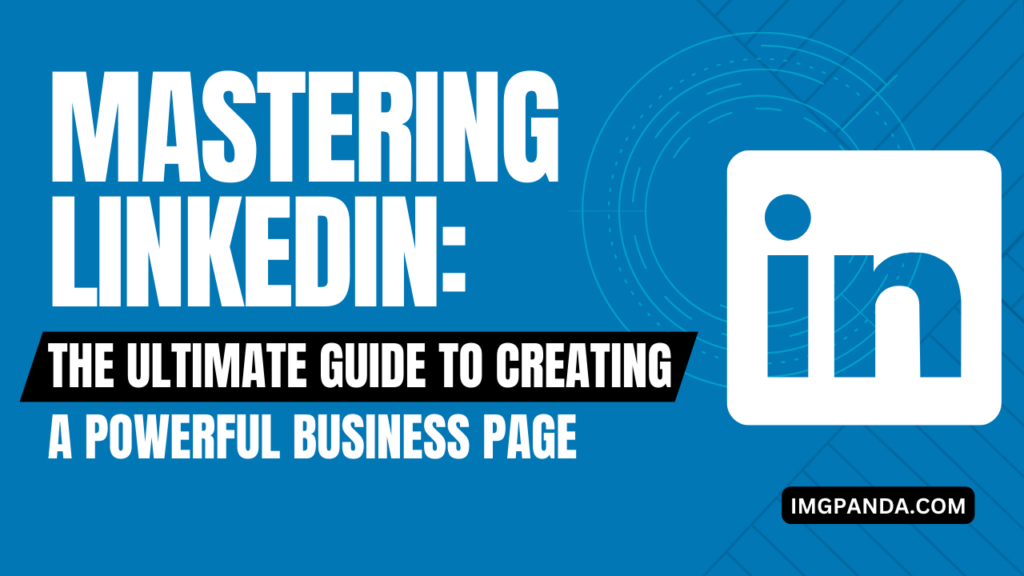1. Introduction:
LinkedIn has emerged as a powerful platform for businesses to establish their online presence, network with professionals, and generate leads. In this ultimate guide, we will dive into the essential steps and strategies to create a compelling business page on LinkedIn. Whether you're a small startup or an established company, mastering LinkedIn can open doors to new opportunities and growth.
From setting up your page and optimizing it for maximum visibility to engaging with your audience and leveraging advanced features, this guide will equip you with the knowledge and tools to create a powerful LinkedIn presence that drives results for your business.
Also Read This: Step-by-Step Guide to Making Paper Flowers
2. Setting Up Your Business Page

A. Creating a LinkedIn profile:
Creating a LinkedIn profile is the first step in establishing your professional presence on the platform. It involves signing up for a LinkedIn account or logging in to an existing account. You will then fill in your details, such as your name, professional headline, current and past work experience, education, and skills.
It's essential to provide a professional profile picture and write a compelling summary that highlights your expertise, accomplishments, and career goals. Additionally, you can include other sections like certifications, volunteer experience, and recommendations to further strengthen your profile's credibility.
B. Choosing the right profile picture and cover photo:
-
Profile picture:
Your profile picture is the first visual impression people will have of you on LinkedIn. Choose a professional and high-quality photo that represents you well. Here are some tips:
-
- Use a recent, clear, and well-lit headshot.
- Dress appropriately for your industry or desired professional image.
- Maintain a friendly and approachable expression.
- Ensure the background is clean and uncluttered.
- Crop the image to focus on your face and shoulders.
-
Cover photo:
The cover photo is a large banner image displayed at the top of your LinkedIn profile. It offers an opportunity to showcase your personality or brand visually. Consider the following suggestions:
- Align the cover photo with your professional brand or industry.
- Use a high-resolution image that reflects your values or expertise.
- Include your company logo or tagline if applicable.
- Experiment with different visuals that convey professionalism and authenticity.
- Ensure the dimensions of the cover photo meet LinkedIn's recommended size (1584 x 396 pixels).
Remember, both the profile picture and cover photo should create a positive and memorable impression while maintaining professionalism. They play a crucial role in attracting potential connections and conveying your personal or brand identity effectively.
C. Optimizing your page headline and description
Your page headline and description on LinkedIn play a crucial role in attracting visitors and communicating your brand's value proposition. To optimize these elements:
- Page Headline: Craft a compelling headline in 120 characters or less that captures attention and concisely conveys your business's unique value. Include relevant keywords to improve search visibility and ensure it aligns with your brand identity.
- Description: In the description, use 2,000 characters to provide an engaging overview of your business. Highlight your expertise, key offerings, and what sets you apart from competitors. Incorporate industry-specific keywords to enhance searchability. Keep it concise and easy to read, using bullet points and clear formatting. Consider adding a call-to-action to encourage visitors to take the desired action, such as visiting your website or contacting you.
By optimizing your page headline and description, you'll effectively communicate your brand's value proposition and attract the right audience on LinkedIn. These elements should be captivating, concise, and optimized with relevant keywords to maximize the impact of your LinkedIn business page.
D. Adding contact information and website links
Including accurate contact information and website links on your LinkedIn business page is crucial for making it easy for visitors to connect with your business and learn more about your offerings. Here's how to optimize this aspect:
- Contact Information: Provide up-to-date contact details such as your business address, phone number, and email. This allows potential clients or partners to reach out to you directly. Double-check the information for accuracy.
- Website Links: Include links to your company's website, blog, or other relevant online platforms. These links provide opportunities for visitors to explore more about your business and engage with your content. Consider adding a call-to-action button that directs visitors to take a specific action, like signing up for a newsletter or requesting a demo.
By adding contact information and website links, you create seamless pathways for engagement, lead generation, and conversion. Visitors can easily connect with your business and access more information, increasing the likelihood of building valuable relationships and driving business growth.
E. Customizing your URL
Customizing your LinkedIn business page URL adds a professional touch to your online presence and makes it easier for others to find and share your page. Follow these steps to customize your URL:
- Go to your LinkedIn business page: Log in to your LinkedIn account and navigate to your business page.
- Access the "Admin Tools" section: Click on the "Admin Tools" button located at the top right corner of your page.
- Select "Public URL": From the dropdown menu, choose "Public URL" or "Public Profile URL."
- Customize your URL: In the "Edit URL" section, you can enter a unique and memorable URL for your page. Ideally, use your business name or a variation of it. LinkedIn will let you know if the desired URL is available.
- Save changes: After entering the desired URL, click on the "Save" or "Apply" button to finalize the customization.
By customizing your LinkedIn business page URL, you create a professional and branded link that is easier to remember and share with others. It enhances your page's visibility and makes it more accessible to potential clients, partners, and industry professionals.
"The video below is about creating a LinkedIn business page."
Also Read This: What Shutterstock Pays for Video and Music Content
3. Crafting Compelling Content
Crafting compelling content is essential to engage your audience, build credibility, and drive meaningful interactions on your LinkedIn business page. Here are some key strategies for creating content that resonates:
- Identify your target audience: Understand who your ideal audience is and tailor your content to their needs, interests, and pain points.
- Establish your brand voice and tone: Define your brand's unique personality and ensure consistency in your messaging. Whether it's informative, conversational, or inspiring, your brand voice should reflect your business's values.
- Create engaging and shareable posts: Use a mix of content formats such as text posts, images, videos, and infographics to keep your audience engaged. Craft compelling headlines, storytelling narratives, and thought-provoking questions to encourage interaction and sharing.
- Utilize multimedia content: Visual elements such as images and videos grab attention and increase content engagement. Incorporate eye-catching visuals that align with your brand and effectively convey your message.
- Incorporate relevant hashtags: Research and use relevant hashtags in your posts to increase discoverability. Hashtags help your content reach a wider audience interested in specific topics or industries.
Remember to analyze your audience's engagement patterns and adapt your content strategy accordingly. Consistently monitor post-performance, encourage discussions, respond to comments, and actively participate in conversations to foster a sense of community on your LinkedIn business page. By crafting compelling content, you'll establish your business as an authority in your industry and attract a loyal following.
Also Read This: Does Team Rumble Provide XP in Fortnite
4. Growing Your LinkedIn Network
Expanding your LinkedIn network is crucial for broadening your reach, connecting with industry professionals, and fostering valuable relationships. Here are effective strategies for growing your LinkedIn network:
- Connect with employees and colleagues: Start by connecting with your employees and colleagues to build a strong foundation. Their connections can provide valuable networking opportunities.
- Engage with industry leaders and influencers: Follow and engage with influential leaders in your industry. Comment on their posts, share valuable insights, and build meaningful connections with them.
- Join relevant LinkedIn groups and communities: Find and join LinkedIn groups that align with your industry or interests. Engage in discussions, share knowledge, and connect with like-minded professionals.
- Participate in discussions and share valuable insights: Be active on LinkedIn by participating in discussions, commenting on posts, and sharing valuable insights. This positions you as a knowledgeable professional and attracts others to connect with you.
- Utilize LinkedIn's advanced search feature: Leverage LinkedIn's advanced search feature to find professionals based on specific criteria such as industry, location, job title, or company. Send personalized connection requests to individuals who align with your networking goals.
By actively growing your LinkedIn network, you increase your visibility, expand your professional circle, and unlock new opportunities for collaboration, mentorship, and business growth. Remember to engage authentically and provide value to others in your network for mutually beneficial relationships.
"The following tweet is about growing your LinkedIn network."
Growing your LinkedIn network helps you build relationships of trust and respect with important decision-makers and can make it simpler for you to do business with them in the future.https://t.co/rXg3ZbXbmR#linkedinmarketing#accountbasedmarketing#marketingagency pic.twitter.com/ChoiiHrGvO
— ABM Hero (@HeroAbm) December 14, 2022
Also Read This: Name Makeover: Changing Your Store Name on Shopify
5. Utilizing LinkedIn Features and Tools

LinkedIn offers a range of features and tools that can amplify your presence, engage your audience, and drive business results. Here's how to leverage some of these powerful LinkedIn tools:
- Showcasing your products and services: Utilize the "Products" and "Services" sections on your LinkedIn business page to highlight your offerings. Include detailed descriptions, images, and client testimonials to enhance credibility.
- Publishing long-form content on LinkedIn Pulse: LinkedIn Pulse allows you to publish and share long-form articles, industry insights, and thought leadership pieces. This helps establish you and your business as an authoritative voice in your industry.
- Utilizing LinkedIn Analytics for performance tracking: LinkedIn's analytics provide valuable insights into the performance of your posts and page. Monitor engagement metrics, track follower growth, and analyze demographics to refine your content strategy.
- Running targeted advertising campaigns: LinkedIn Ads enables you to run highly targeted campaigns to reach specific audiences based on criteria like job title, industry, or location. Use this feature to promote your content, generate leads, or drive traffic to your website.
- Leveraging LinkedIn's talent solutions for recruitment: If you're looking to hire talent, LinkedIn's talent solutions like LinkedIn Recruiter and Job Posts can help you find qualified candidates and streamline your hiring process.
By utilizing these features and tools, you can effectively showcase your offerings, establish thought leadership, measure the success of your LinkedIn efforts, reach your target audience through targeted advertising, and leverage LinkedIn for recruitment purposes. Stay up-to-date with new features and explore how they align with your business goals to maximize the benefits of LinkedIn's diverse toolkit.
Also Read This: How to Create a New Skype Account Quick Setup Instructions Featured on Dailymotion
6. Building Thought Leadership
Building thought leadership on LinkedIn positions you and your business as industry experts, enhances credibility, and fosters trust among your audience. Here's how to establish yourself as a thought leader on LinkedIn:
- Share valuable and insightful content: Consistently share high-quality content that provides unique perspectives, industry insights, and practical tips. Offer valuable solutions to common challenges and demonstrate your expertise in your field.
- Engage in meaningful discussions: Participate in discussions on LinkedIn by commenting on relevant posts, offering thoughtful insights, and sharing your expertise. Engage with other thought leaders, influencers, and professionals to expand your network and establish your presence.
- Publish long-form articles: Utilize LinkedIn Pulse to publish long-form articles on topics within your industry. Share your expertise, research, and thought-provoking ideas to demonstrate your depth of knowledge.
- Collaborate with other thought leaders: Identify and connect with other thought leaders in your industry. Collaborate on projects, co-author articles, or participate in joint webinars or podcasts. This not only expands your reach but also reinforces your credibility.
- Seek endorsements and recommendations: Encourage clients, colleagues, and industry peers to provide endorsements and recommendations on your LinkedIn profile. These testimonials further validate your expertise and enhance your thought leadership.
- Speak at industry events or host webinars: Seek opportunities to speak at industry conferences, webinars, or events. Sharing your expertise in front of a larger audience positions you as a trusted authority.
Consistency, authenticity, and providing value are key to building thought leadership on LinkedIn. By consistently sharing valuable content, engaging with others, and collaborating with industry experts, you can establish yourself and your business as thought leaders in your field.
Also Read This: The Death of Hurrem Sultan Unveiled
7. Measuring Success and Iterating

Measuring the success of your LinkedIn efforts is crucial for understanding what works, optimizing your strategy, and achieving your business goals. Here's how to effectively measure success and iterate on your LinkedIn activities:
- Define your objectives: Clearly define your LinkedIn goals, whether it's increasing brand awareness, generating leads, driving website traffic, or establishing thought leadership. Align your metrics with these objectives.
- Track engagement metrics: Monitor key engagement metrics such as post views, likes, comments, and shares. Analyze which types of content resonate most with your audience and generate the highest engagement.
- Assess follower growth: Keep track of your follower growth over time. Analyze which content or activities led to spikes in followers and identify trends that contribute to increased engagement.
- Measure website traffic and conversions: Utilize tools like Google Analytics to track website traffic coming from LinkedIn. Set up goals and conversion tracking to assess the effectiveness of LinkedIn in driving desired actions on your website.
- Analyze LinkedIn page analytics: LinkedIn provides page analytics that offers insights into your page's performance. Examine metrics like reach, impressions, follower demographics, and engagement trends to inform your content strategy.
- Gather feedback and listen to your audience: Pay attention to comments, messages, and feedback from your audience. Use this information to understand their preferences, pain points, and interests. Incorporate their feedback into your content strategy.
- Iterate and optimize your strategy: Based on your measurement results, iterate and refine your LinkedIn strategy. Experiment with different content formats, posting schedules, and messaging techniques to continuously improve your performance.
Regularly reviewing your LinkedIn metrics, analyzing audience feedback, and making data-driven decisions will help you refine your approach, maximize your success, and drive meaningful results on the platform. Be open to testing new strategies and adapting to the evolving needs of your audience and the LinkedIn platform itself.
Also Read This: Exploring the Historical Documentary of Our Fathers' Nazi Legacy on Dailymotion
Frequently Asked Questions (FAQs)
1. Why should I create a LinkedIn business page?
Creating a LinkedIn business page allows you to establish an online presence for your business, connect with professionals in your industry, showcase your products or services, and build credibility in the business community. It provides a platform to engage with your target audience, share valuable content, and attract potential clients, partners, and employees.
2. Can I create a LinkedIn business page if I already have a personal LinkedIn profile?
Yes, you can create a LinkedIn business page even if you already have a personal LinkedIn profile. Having both a personal profile and a business page can complement each other, as your profile can help promote your business page and vice versa.
3. How can I optimize my LinkedIn business page for better visibility?
To optimize your LinkedIn business page, ensure that you provide accurate and engaging information about your business, including a compelling headline, a well-crafted description, and relevant keywords. Customize your URL to reflect your brand and make it memorable. Additionally, regularly share high-quality and valuable content, engage with your audience, and leverage LinkedIn's features and tools to enhance visibility and engagement.
4. How can I grow my LinkedIn network?
Growing your LinkedIn network involves connecting with relevant professionals in your industry, engaging with thought leaders and influencers, joining relevant LinkedIn groups, and actively participating in discussions. Utilize LinkedIn's advanced search feature to find and connect with individuals who align with your networking goals. Consistently provide value, share insights, and engage authentically to foster meaningful connections.
5. How can I build thought leadership on LinkedIn?
To build thought leadership on LinkedIn, share valuable and insightful content, participate in discussions, publish long-form articles on LinkedIn Pulse, collaborate with other thought leaders, seek endorsements and recommendations, and leverage speaking opportunities. Consistency, authenticity, and providing value to your audience are key factors in establishing yourself and your business as thought leaders.
6. How can I measure the success of my LinkedIn efforts?
Measuring the success of your LinkedIn efforts involves tracking engagement metrics such as post views, likes, comments, and shares, monitoring follower growth, analyzing website traffic and conversions from LinkedIn, and utilizing LinkedIn page analytics. It's important to define clear objectives, align metrics with your goals, and regularly review and analyze the data to inform your content strategy and make necessary adjustments.
Remember, LinkedIn is a dynamic platform, and it's essential to stay updated with the latest features and best practices to make the most of your LinkedIn business page and achieve your business objectives.
Conclusion
Mastering LinkedIn and creating a powerful business page is a valuable asset for any business. By optimizing your profile, leveraging LinkedIn features, and providing valuable content, you can build a strong network, establish thought leadership, and drive meaningful engagement.
Regularly measuring the success of your efforts and iterating your strategy based on data will ensure continuous improvement. LinkedIn offers endless opportunities for connecting with professionals, expanding your reach, and achieving your business goals. Embrace the power of LinkedIn and unlock the potential it holds for your business's growth and success.
